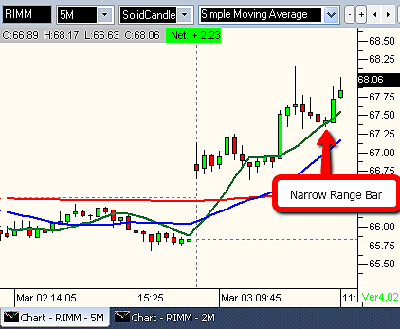A recent trade on RIMM shows the power and precision of the narrow range bar (NRB) as a low-risk trade entry signal.
By Jamie Theiss
The narrow range bar (NRB) is one of my favorite reversal signals. It provides for very tight stops, making it one of the lowest-risk entry signals out there. While there may be no technical definition of an NRB, just by looking at Figure 1 below, you will know it when you see it. They are simply significantly smaller than the previous bars to the left. The reason NRBs are so powerful is they are like a coiled spring under pressure. The normal volatility is compressed into a tiny range. One side or the other must capitulate, resulting in often-explosive movements. However, you don't need the explosive movement; just a return to normal volatility brings significant profits.
To set up this trade on Research in Motion (RIMM), we had a bullish gap up that morning along with rising moving averages on the upper time frame 15- and 60-minute charts. So we were looking for buyable events on pullbacks. I identified the NRB on the chart, and it worked well. Looking to the left of the NRB, you can see obvious bars that are significantly bigger. That tall green bar is $0.66 wide and the topping tail bar is $0.65. From that topping tail bar, you have the next three red bars being compressed, just like a coiled spring. The first red bar's range is $0.46 wide. The next is $0.30, and then $0.21. The final bar is compressed down to only $0.15.
As a bonus, it is located right on the eight-period moving average line (green).
I use an entry signal that is $0.01 above the high of the NRB with the stop $0.01 below it. This is a very tight stop, of course, so position sizing correctly allows you to load up the share size while keeping your risk amount the same. For example, if you have a $100 risk per trade, using $0.17 as your risk, you can get 600 shares. If you had a more normal-sized bar of $0.35 or $0.40, your share size could only be approximately 250 shares to maintain the same $100 risk.
As you can see, the very next bar brings a return to normal volatility and a range of $0.51. Just that five-minute bar alone brings a three-to-one return on risk. Depending on your personal trail method and exit technique, even greater profit could have been achieved. You can use the NRB on any time frame chart, not just this five-minute example.
I hope you can see and appreciate the value of the narrow range bar as an entry signal worth looking for and implementing into your trading plan.
Jamie Theiss is a full-time indpendent trader



















